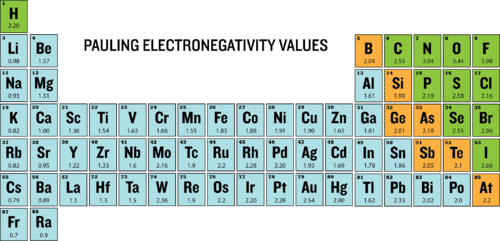Is it easy or hard for you to make new friends?
Have you ever noticed how some people attract others to them? Whether it is their personality, attractiveness, or athletic skills – something pulls people toward them, while others have a smaller group of friends and acquaintances. Atoms do the same thing. One atom may pull electrons strongly to it, while a second type of atom has much less “pulling power.”
Electronegativity
Valence electrons of both atoms are always involved when those two atoms come together to form a chemical bond. Chemical bonds are the basis for how elements combine with one another to form compounds. When these chemical bonds form, atoms of some elements have a greater ability to attract the valence electrons involved in the bond than other elements.
Electronegativity is a measure of the ability of an atom to attract the electrons when the atom is part of a compound. Electronegativity differs from electron affinity because electron affinity is the actual energy released when an atom gains an electron. Electronegativity is not measured in energy units, but is rather a relative scale. All elements are compared to one another, with the most electronegative element, fluorine, being assigned an electronegativity value of 3.98. Fluorine attracts electrons better than any other element. The table below shows the electronegativity values for the elements.
The electronegativity scale was developed by Nobel Prize winning American chemist Linus Pauling. The largest electronegativity (3.98) is assigned to fluorine and all other electronegativities measurements are on a relative scale. [Figure2]
Since metals have few valence electrons, they tend to increase their stability by losing electrons to become cations. Consequently, the electronegativities of metals are generally low. Nonmetals have more valence electrons and increase their stability by gaining electrons to become anions. The electronegativities of nonmetals are generally high.
Trends
Electronegativities generally increase from left to right across a period. This is due to an increase in nuclear charge. Alkali metals have the lowest electronegativities, while halogens have the highest. Because most noble gases do not form compounds, they do not have electronegativities. Note that there is little variation among the transition metals. Electronegativities generally decrease from top to bottom within a group due to the larger atomic size.
Of the main group elements, fluorine has the highest electronegativity (EN = 4.0) and cesium the lowest (EN = 0.79). This indicates that fluorine has a high tendency to gain electrons from other elements with lower electronegativities. We can use these values to predict what happens when certain elements combine. The following video shows this.
When the difference between electronegativities is greater than ~1.7, then a complete exchange of electrons occurs. Typically this exchange is between a metal and a nonmetal. For instance, sodium and chlorine will typically combine to form a new compound and each ion becomes isoelectronic with its nearest noble gas. When we compare the EN values, we see that the electronegativity for Na is 0.93 and the value for Cl is 3.2. The absolute difference between ENs is |0.93 - 3.2| = 2.27. This value is greater than 1.7, and therefore indicates a complete electron exchange occurs.
Summary
- Electronegativity is a measure of the ability of an atom to attract the electrons when the atom is part of a compound.
- Electronegativity values generally increase from left to right across the periodic table.
- Electronegativities generally decrease from top to bottom of a group.
- The highest electronegativity value is for fluorine.

